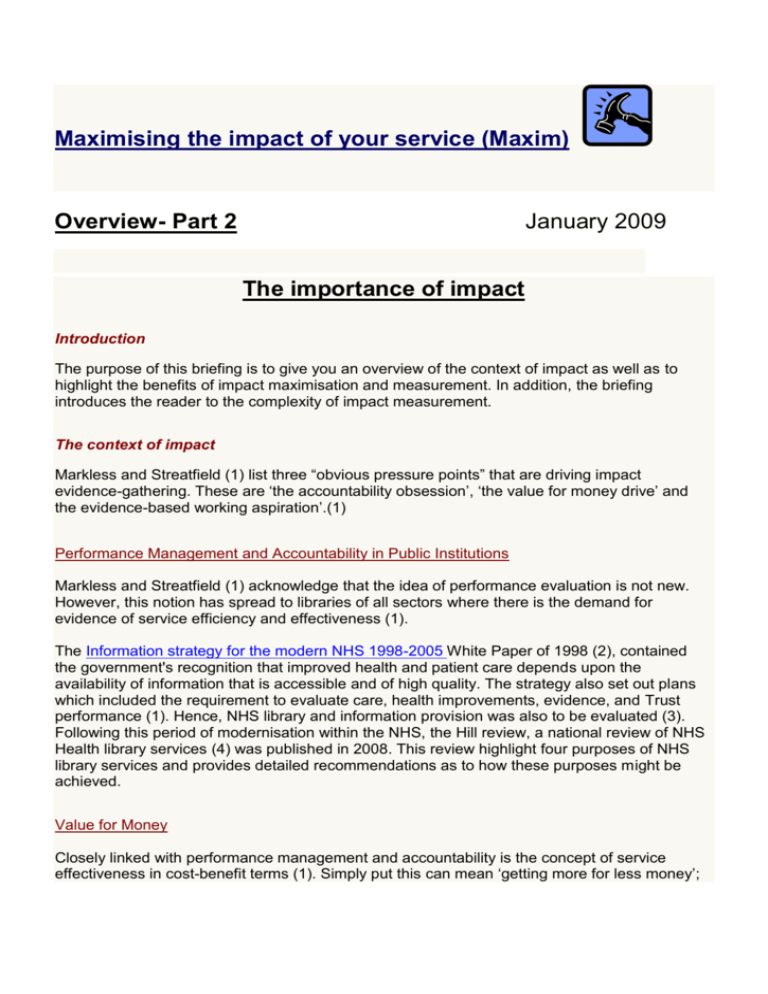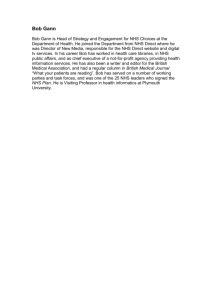FOLIO
advertisement

Maximising the impact of your service (Maxim) Overview- Part 2 January 2009 The importance of impact Introduction The purpose of this briefing is to give you an overview of the context of impact as well as to highlight the benefits of impact maximisation and measurement. In addition, the briefing introduces the reader to the complexity of impact measurement. The context of impact Markless and Streatfield (1) list three “obvious pressure points” that are driving impact evidence-gathering. These are ‘the accountability obsession’, ‘the value for money drive’ and the evidence-based working aspiration’.(1) Performance Management and Accountability in Public Institutions Markless and Streatfield (1) acknowledge that the idea of performance evaluation is not new. However, this notion has spread to libraries of all sectors where there is the demand for evidence of service efficiency and effectiveness (1). The Information strategy for the modern NHS 1998-2005 White Paper of 1998 (2), contained the government's recognition that improved health and patient care depends upon the availability of information that is accessible and of high quality. The strategy also set out plans which included the requirement to evaluate care, health improvements, evidence, and Trust performance (1). Hence, NHS library and information provision was also to be evaluated (3). Following this period of modernisation within the NHS, the Hill review, a national review of NHS Health library services (4) was published in 2008. This review highlight four purposes of NHS library services and provides detailed recommendations as to how these purposes might be achieved. Value for Money Closely linked with performance management and accountability is the concept of service effectiveness in cost-benefit terms (1). Simply put this can mean ‘getting more for less money’; this may lead to a ‘funding based on results’ type approach (1). This makes gathering evidence of impact of your service essential. Poll and Payne (2006) also note the importance of demonstrating benefits gained from running a library service to our users, not only our funding institutions. Electronic information is often now freely available (or perhaps appears to be freely available even when libraries have paid for access) and physical library visits are declining (5). Funding libraries is expensive - Poll and Payne (2006) note that “… in the competition for scarce resources, it becomes vital for libraries to show evidence of the impact and value of their services, preferably in quantified results” (5) Evidence-based working aspiration In recent years, evidence-based practice has become widely used in the medical field. A definition of evidence-based practice is, "an approach to health care wherein health professionals use the best evidence possible, i.e. the most appropriate information available, to make clinical decisions for individual patients" (6). Similarly, the evaluation of impact in health library and information services is an evidence-based practice because any library service changes or developments are based on evidence. User centredness Lastly, it is important that Impact maximisation must be user focused. Creating services that are focused upon the needs of users is a widely used and effective strategy in library and information services development: "a service that is not attuned to the needs of its users may become underutilised, redundant or even obsolete" (7) Why is impact important? NHS libraries usually measure the performance of their service using quantitative methods such as usage statistics and user surveys (8). However, although this information is highly useful, it does not explain why users use library services, nor does this type of data explain the difference that these services have made to users. Impact evaluation is important because it is primarily concerned with the usefulness of library services to users i.e. - the effectiveness of outcomes rather than the efficiency of processes in information services (8). What are the benefits? The benefits of maximising impacts include: Increased usefulness of services for users Greater user satisfaction with services Increased usage of library services The benefits of measuring impacts are that impact studies: Can be used as tools to communicate service benefits to users Can be a powerful tool for demonstrating accountability and justifying funding needs to funding bodies and those responsible for resource allocation Can be used to build partnerships and collaborations with users Can help information services to determine which services should be expanded or replicated Can be used as a tool to single out exemplary services for recognition (9) What are the difficulties in measuring impact? Impact is defined as “any effect of the service (or of an event or initiative) on an individual or group” (1). However, measuring this 'difference' can be complex. Markless and Streatfield (1) in their glossary of terms relating to impact distinguish between impact evaluation and impact measurement. Impact evaluation: Evaluating impact using qualitative terms Impact measurement: Evaluating impact using quantitative methods (numbers) (1) Markless and Streatfield (1) advise against using a purely quantitative approach since this can lead to concentration on outputs rather than outcomes. In practice, a mix of quantitative and qualitative data collection methods is often used to capture information about impact. Quantitative performance measurement methods such as user surveys statistically display the usage of services and user satisfaction with services. Qualitative data collection methods such as interviews usually provide a follow-up to the quantitative methods. Qualitative data can help to explain why users are satisfied (or dissatisfied!) with services as well as to explain why users use the services that they have identified in the quantitative survey and how these services have affected them. Despite the usefulness of quantitative and qualitative data collection methods in impact evaluation, impact can sometimes be difficult to prove (10). For example, if a clinician starts to prescribe statins to his/her patients, it is hard to prove if this alteration has been influenced by the results of a mediated literature search on stroke prevention that he/she has received from his/her NHS library (11). In certain cases, quantitative and qualitative data collection methods can only enable services to make informed assumptions about the impact that their services has on its users (8). Nevertheless, two recent studies, one a systematic review, have demonstrated how library services can have a positive impact directly on patient care (12, 13). These issues will be explored later in the Maxim course. WHAT YOU NEED TO DO: Read the following self-reflective questions and record your answers in your portfolio: a) How has your library or information service attempted to maximise the impact of its services to users? b) Did these impact maximising activities have any effect on your library or information service?* *If your workplace has not attempted to maximise impact, please provide reasons as to why this may be the case. In addition, please provide examples of the ways in which impact could be maximised in your library or information service and provide examples of the potential effects that maximising impact could have on your service. References 1. Markless, S; Streatfield, D (2006). "Evaluating the impact of your library" London, England, UK: Facet Publishing. 2. NHS Executive. Information strategy for the modern NHS 1998-2005. London, Department of Health, 1998. [Online] [Accessed January 2009] 3. Banwell, L. "Evaluating information services" Chapter 13, pp173 - 181. In: (eds) Andrew Booth and Graham Walton, Managing Knowledge in Health Services. London, Library Association publishing; 2000 [Online] [Accessed January 2009] 4. Hill, P (2008). Report of a national review of NHS health library services in England: From knowledge to health in the 21st Century [Online] [Accessed January 2009] 5. Poll, R and Payne, P (2006). Impact measures for libraries and information services. Library Hi Tech 24 (4): 547-562. Preprint at: http://conference.ub.unibielefeld.de/2006/proceedings/payne_poll_final_web.pdf [Online] [Accessed January 2009] 6. McKibbon KA (1998). Evidence based practice. Bulletin of the Medical Library Association 86 (3): 396-401. 7. Booth, A. 'Identifying users' needs Chapter 7, pp101-111. In: (eds) Andrew Booth and Graham Walton, Managing Knowledge in Health Services. London, Library Association publishing; 2000 [Online] [Accessed January 2009] 8. O'Connor, P. Determining the impact of health library services on patient care: a review of the literature. Health Information and Libraries Journal 2002; 19: 1-13. 9. Rudd, PD. Documenting the difference: demonstrating the value of libraries through outcome measurement. Perspectives on Outcome Based Evaluation for Libraries and Museums. Washington, Institute of Museum and Library Services; 1999 [Online] [Accessed January 2009] 10. Everest, K and Payne, P. The Impact of Libraries on Learning, Teaching and Research Report of the LIRG seminar held in Leeds. 30th October 2001. [Online] [Accessed January 2009] 11. Roberts. S. Do libraries aid learning? Approaches and methods for measuring impact Report about the conference. 9-10 December 2002, Scarborough. [Online] [Accessed January 2009] 12. Weightman, A. L. & Williamson, J. 2005, "The value and impact of information provided through library services for patient care: a systematic review", Health Information and Libraries Journal, 22, 1, 4-25. 13. Lacey Bryant, S and Gray, A (2006). Demonstrating the positive impact of information support on patient care in primary care: a rapid literature review. Health Information and Libraries Journal;. 23: 118-125





